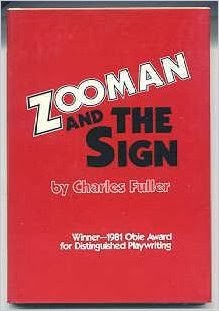Mirror of Violence: Charles Fuller’s Zooman and the Sign
 It is a truth, widely recognized, that blue-blooded and red-blooded Americans love violence. To be sure, it is deemed unpatriotic to detest violence, which along with “race” is a permanent fixture in the minds of Americans. Like esteemed works of ancient world literature, contemporary American literature idolizes violence. Literary and cultural critics who condemn violence in art and in life are naive candidates for mental asylums, because unquestioned embrace of violence is the sign of one’s 21st century humanity. It is a deeper truth, however, that Americans are ambivalent about disregard for the sanctity of human life. They applaud it until one of their children is killed by another person’s child. Tears of grief flow like waterfalls. Anti-violence protests sprout like mushrooms and people wear costumes of solidarity, then disappear when the next episode of violence begins on television, in sports stadiums and cinema, or goes viral on the Internet. We are paragons of human contradiction.
It is a truth, widely recognized, that blue-blooded and red-blooded Americans love violence. To be sure, it is deemed unpatriotic to detest violence, which along with “race” is a permanent fixture in the minds of Americans. Like esteemed works of ancient world literature, contemporary American literature idolizes violence. Literary and cultural critics who condemn violence in art and in life are naive candidates for mental asylums, because unquestioned embrace of violence is the sign of one’s 21st century humanity. It is a deeper truth, however, that Americans are ambivalent about disregard for the sanctity of human life. They applaud it until one of their children is killed by another person’s child. Tears of grief flow like waterfalls. Anti-violence protests sprout like mushrooms and people wear costumes of solidarity, then disappear when the next episode of violence begins on television, in sports stadiums and cinema, or goes viral on the Internet. We are paragons of human contradiction.
That point is excellently depicted in Charles Fuller’s play Zooman and the Sign (1978). Zooman received the 1981 Obie Award in Distinguished Playwriting. The next year, Fuller won a Pulitzer Prize for A Soldier’s Play, which was later filmed as A Soldier’s Story. Fuller’s reputation is secure, but Zooman is sometimes dismissed for exposing “secrets” about black on black urban crime. It is puzzling how what gets reported daily is in anyway “secret.” What is truly secret about Zooman is its value as a local mirror for American pathology and the universal banality of violence. We fail to appreciate that Zooman, the title character, is an icon for adolescents who plot to kill their classmates and teachers in Colorado and other states. We fail to align him at the adult level with George Zimmerman types (including policemen of any ethnicity) who experience orgasmic pleasure in murdering African Americans. The sign THE KILLERS OF [fill in this blank] ARE FREE ON THE STREETS BECAUSE OUR NEIGHBORS WILL NOT IDENTIFY THEM! indicts neighbors everywhere who see nothing, hear nothing, and say nothing. The sign indicts our very “normal” embrace of violence, our casual “literary” acceptance of Zooman’s justification of a child’s being killed by one of his stray bullets: “She was in the wrong place at the wrong time—how am I supposed to feel guilty over somethin’ like that? Shiiit, I don’t know the little bitch, anyway.” The justification is a fine example of military rhetoric.
The text of Zooman should be read through the grid provided by Robin D.G. Kelley’s YO’ MAMA’S disFUNKtional!: Fighting the Culture Wars in Urban America (1997). Kelley urges us to “remain suspicious of liberal pluralism dressed up in postmodern garb, of analyses that completely ignore history or questions of power, of narrow identity politics that presumes people are the sum of our academic categories, of the tendency to limit our critiques of people’s actions to moral chastisement” (179-180). Kelley’s advice enables us to see better what exactly is reflected in the American mirror of violence.